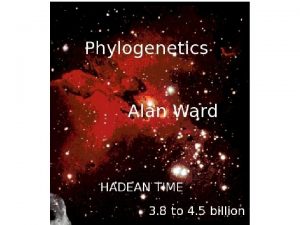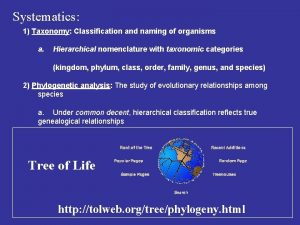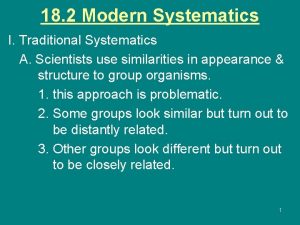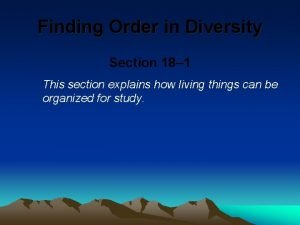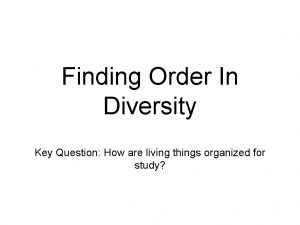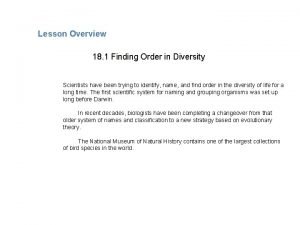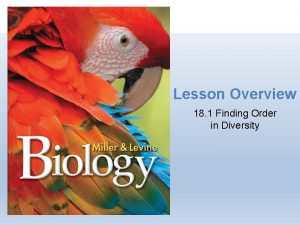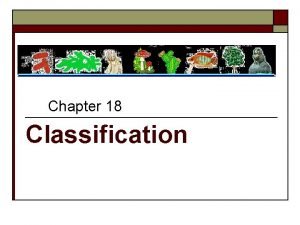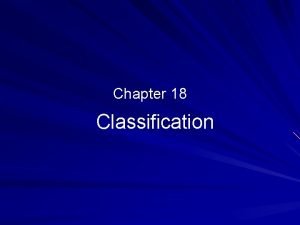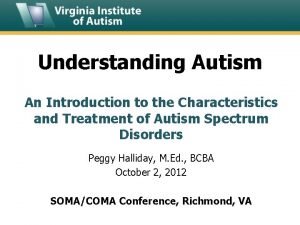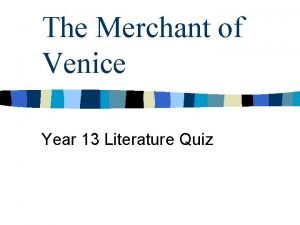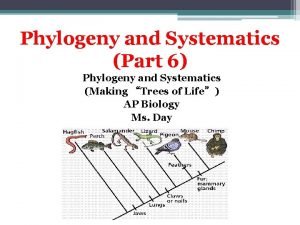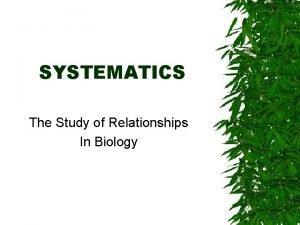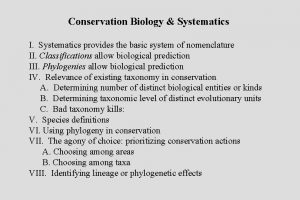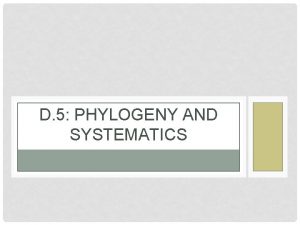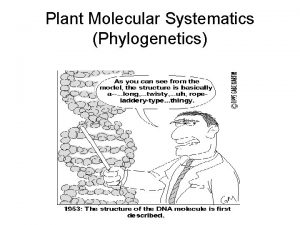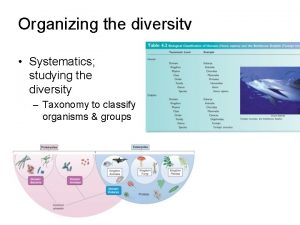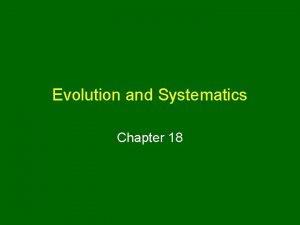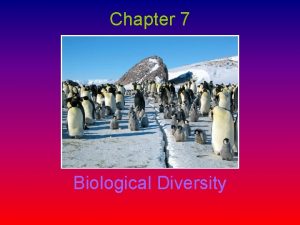Chapter 18 Systematics Seeking Order Amidst Diversity Copyright



















- Slides: 19

Chapter 18 • Systematics: Seeking Order Amidst Diversity Copyright © 2005 Pearson Prentice Hall, Inc.

Copyright © 2005 Pearson Prentice Hall, Inc.

How Are Organisms Named and Classified? • Classification of Selected Organisms, Reflecting Their Degree of Relatedness* (T 18. 1 p. 346) Copyright © 2005 Pearson Prentice Hall, Inc.

Three species of bluebird (F 18. 1 p. 346) Copyright © 2005 Pearson Prentice Hall, Inc.

How Are Organisms Named and Classified? • Classification Originated as a Hierarchy of Categories • Systematists Identify Features That Reveal Evolutionary Relationships • Anatomy Plays a Key Role in Systematics – Microscopic structures may be used to classify organisms (F 18. 2 p. 347) Copyright © 2005 Pearson Prentice Hall, Inc.

How Are Organisms Named and Classified? • Molecular Similarities Are Also Useful for Reconstructing Phylogeny – Human & chimp chromosomes are similar (F 18. 3 p. 348) Copyright © 2005 Pearson Prentice Hall, Inc.

What Are the Domains of Life? • The Five-Kingdom System Improved Classification • A Three-Domain System More Accurately Reflects Life’s History – Two domains of prokaryotic organisms – The tree of life Copyright © 2005 Pearson Prentice Hall, Inc. (F 18. 4 p. 349) (F 18. 5 p. 349)

Copyright © 2005 Pearson Prentice Hall, Inc.

EUKARYA BACTERIA ARCHAEA animals fungi plants protists The tree of life Copyright © 2005 Pearson Prentice Hall, Inc. (F 18. 5 p. 349)

What Are the Domains of Life? • Kingdom-Level Classification Remains Unsettled – Relatedness can be determined by comparing DNA sequences (FE 18. 1 p. 350) – A closer look at the eukaryotic tree of life (F 18. 6 p. 351) Copyright © 2005 Pearson Prentice Hall, Inc.

Copyright © 2005 Pearson Prentice Hall, Inc. Chordata (tunicates, lancelets, vertebrates) Echinodermata (sea stars, sea urchins, sea cucumbers) Arthropoda (insects, arachnids, crustaceans) Annelida (segmented worms) FUNGI Mollusca (snails, clams, squid) Platyhelminthes (flatworms) Cnidaria (hydras, anemones, jellyfish) Porifera (sponges) Basidiomycota (club fungi) PLANTAE Ascomycota (sac fungi) Zygomycota (zygote fungi) Anthophyta (flowering plants) Coniferophyta (conifers) Pteridophyta (ferns) Bryophyta (liverworts, mosses) Chlorophyta (green algae) Oomycota (water molds) Phaeophyta (brown algae) Rhodophyta (red algae) Euglenophyta (euglenoids) Ciliophora (ciliates) Pyrrophyta (dinoflagellates) Apicomplexa (sporozoans) Sarcomastigophora (zooflagellates, sarcodines) “PROTISTS” ANIMALIA to Archaea to Bacteria Activity 18. 2

Human Chimp Common Pygmy chimp Gorilla Orangutan gibbon Evolutionary Relationships by DNA Analysis Copyright © 2005 Pearson Prentice Hall, Inc.

Why Do Classifications Change? • Species Designations Change When New Information Is Discovered • The Biological Species Definition Can Be Difficult or Impossible to Apply – The Phylogenetic Species Concept Offers an Alternative Definition Copyright © 2005 Pearson Prentice Hall, Inc.

How Many Species Exist? • The black-faced lion tamarin (F 18. 7 p. 352) • Reptiles are not a monophyletic group (F 18. 8 p. 353) • Evolutionary analysis helps reveal the origin of HIV (F 18. 9 p. 354) Copyright © 2005 Pearson Prentice Hall, Inc.

Copyright © 2005 Pearson Prentice Hall, Inc.

1 2 3 4 1 -4 are monophyletic 1 2 3 on the left (ALL the descendants of one common ancestor) But NOT on the right A Reptiles are not monophyletic!! Crocodiles Birds Snakes Copyright © 2005 Pearson Prentice Hall, Inc. Lizards Turtles A 4

1 2 3 4 A Copyright © 2005 Pearson Prentice Hall, Inc. 1 2 3 A 4

Crocodiles Birds Snakes Copyright © 2005 Pearson Prentice Hall, Inc. Lizards Turtles

Human HIVs Do Not Cluster HIV-1 (strain 1) SIV-chimpanzee (strain 1) HIV-1 (strain 2) SIV-chimpanzee (strain 2) SIV-mandrill 2 Separate Cross. Species Jumps: One of HIV-1 HIV-2 (strain 1) & SIV-sooty mangeby monkey SIV-pig-tailed macaque HIV-2 (strain 2) Copyright © 2005 Pearson Prentice Hall, Inc. One of HIV-2
 Joy amidst suffering
Joy amidst suffering Poverty amidst plenty
Poverty amidst plenty Systematics vs taxonomy
Systematics vs taxonomy Synapomorphy
Synapomorphy Traditional systematics
Traditional systematics Systematics deals with
Systematics deals with Section 2 modern classification
Section 2 modern classification Genetic diversity and biodiversity
Genetic diversity and biodiversity Ecosystem jigsaw activity
Ecosystem jigsaw activity 1st order 2nd order 3rd order neurons
1st order 2nd order 3rd order neurons Milady chapter 30 pdf
Milady chapter 30 pdf 18-1 finding order in diversity answer key
18-1 finding order in diversity answer key Species genus family order
Species genus family order Finding order in diversity
Finding order in diversity Finding order in diversity 2
Finding order in diversity 2 Finding order in diversity
Finding order in diversity Section 18-1 finding order in diversity
Section 18-1 finding order in diversity Panda domain classification
Panda domain classification Replacement behaviors for attention seeking
Replacement behaviors for attention seeking What does bassanio offer the young lawyer who save antonio
What does bassanio offer the young lawyer who save antonio


